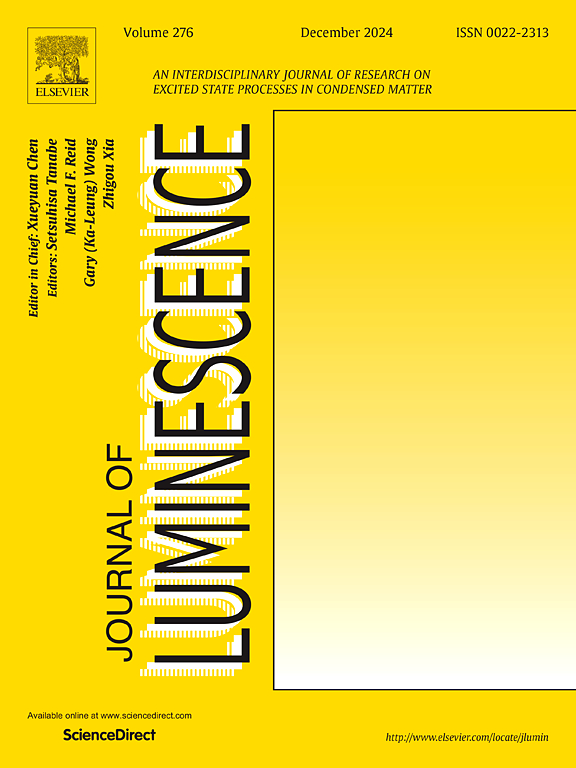Exploring the luminescence mechanism and enabling tunable emission in Sr3YGa2O7.5: Bi3+, Eu3+ phosphors for advanced UV-converted white LEDs
IF 3.3
3区 物理与天体物理
Q2 OPTICS
引用次数: 0
Abstract
Inorganic phosphors with tunable broadband emission hold significant applications in solid-state lighting. Herein, a series of novel Sr3YGa2O7.5: Bi3+, Eu3+ (abbreviated as SYGO: Bi3+, Eu3+) phosphors with tunable optical properties were synthesized by high-temperature solid-state reaction process. The photoluminescence excitation (PLE) spectrum of Sr3YGa2O7.5: Bi3+ ranges from 200 to 400 nm with two peaks at 280 and 331 nm, matching well with the n-UV chip based white light-emitting diodes (WLED). Under ultraviolet light excitation, a single Bi3+-doped Sr3YGa2O7.5 phosphor exhibited five distinct luminescence peaks at 410, 510, 560, 605, and 700 nm at 10 K, which are attributed to the 3P1→1S0 transition emissions of Bi3+ ions occupying the four Sr sites and one Y site within the Sr3YGa2O7.5 host lattice. The optical tuning of the Sr3YGa2O7.5: Bi3+ phosphor is achieved by designing the Bi3+→Eu3+ energy transfer and changing the excitation wavelength based on the selected site occupation. The Commission Internationale de l'Eclairage (CIE) coordinates and emission color of the Sr3YGa2O7.5: Bi3+, Eu3+ phosphors were successfully tuned from blue via white to red. The energy transfer efficiency from Bi3+ to Eu3+ can reach as high as 89.54 %, and this energy transfer process is predominantly governed by the dipole-quadrupole interaction. In addition, the white LED device prepared by combination of SYGO: 0.02Bi3+, 0.03Eu3+ phosphors with 365 nm chip has high color rendering index (CRI) of 85.5 and low correlated color temperature of 3537 K. As the driving current increases, the white light emitting diodes (WLED) device demonstrates good color stability. Based on these findings, the synthesized SYGO: Bi3+, Eu3+ phosphors can serve as color-tunable and single-phase white phosphors with potential applications in UV-excited white LEDs.
探索Sr3YGa2O7.5: Bi3+, Eu3+荧光粉的发光机制并实现可调发射,用于先进的紫外转换白光led
具有可调谐宽带发射的无机荧光粉在固态照明中有着重要的应用。本文采用高温固相反应法制备了一系列光学性能可调的新型Sr3YGa2O7.5: Bi3+, Eu3+(简称SYGO: Bi3+, Eu3+)荧光粉。Sr3YGa2O7.5: Bi3+的光致发光激发(PLE)光谱范围为200 ~ 400 nm,在280和331 nm处有两个峰,与n-UV芯片型白光发光二极管(WLED)匹配良好。在紫外光激发下,单个Bi3+掺杂的Sr3YGa2O7.5荧光粉在10 K时在410、510、560、605和700 nm处表现出5个不同的发光峰,这是由于Bi3+离子占据Sr3YGa2O7.5主晶格内的4个Sr位和1个Y位的3P1→1so0跃迁发射所致。Sr3YGa2O7.5: Bi3+荧光粉的光学调谐是通过设计Bi3+→Eu3+的能量转移和根据所选择的位置占用改变激发波长来实现的。Sr3YGa2O7.5: Bi3+, Eu3+荧光粉的国际发光委员会(CIE)坐标和发射色成功地由蓝色经白色调到红色。Bi3+向Eu3+的能量传递效率高达89.54%,这种能量传递过程主要受偶极-四极相互作用支配。此外,将SYGO: 0.02Bi3+, 0.03Eu3+荧光粉与365 nm芯片组合制备的白光LED器件具有85.5的高显色指数(CRI)和3537 K的低相关色温。随着驱动电流的增大,白光发光二极管(WLED)器件呈现出良好的色彩稳定性。基于这些发现,合成的SYGO: Bi3+, Eu3+荧光粉可以作为颜色可调的单相白色荧光粉,在紫外光激发的白光led中具有潜在的应用前景。
本文章由计算机程序翻译,如有差异,请以英文原文为准。
求助全文
约1分钟内获得全文
求助全文
来源期刊

Journal of Luminescence
物理-光学
CiteScore
6.70
自引率
13.90%
发文量
850
审稿时长
3.8 months
期刊介绍:
The purpose of the Journal of Luminescence is to provide a means of communication between scientists in different disciplines who share a common interest in the electronic excited states of molecular, ionic and covalent systems, whether crystalline, amorphous, or liquid.
We invite original papers and reviews on such subjects as: exciton and polariton dynamics, dynamics of localized excited states, energy and charge transport in ordered and disordered systems, radiative and non-radiative recombination, relaxation processes, vibronic interactions in electronic excited states, photochemistry in condensed systems, excited state resonance, double resonance, spin dynamics, selective excitation spectroscopy, hole burning, coherent processes in excited states, (e.g. coherent optical transients, photon echoes, transient gratings), multiphoton processes, optical bistability, photochromism, and new techniques for the study of excited states. This list is not intended to be exhaustive. Papers in the traditional areas of optical spectroscopy (absorption, MCD, luminescence, Raman scattering) are welcome. Papers on applications (phosphors, scintillators, electro- and cathodo-luminescence, radiography, bioimaging, solar energy, energy conversion, etc.) are also welcome if they present results of scientific, rather than only technological interest. However, papers containing purely theoretical results, not related to phenomena in the excited states, as well as papers using luminescence spectroscopy to perform routine analytical chemistry or biochemistry procedures, are outside the scope of the journal. Some exceptions will be possible at the discretion of the editors.
 求助内容:
求助内容: 应助结果提醒方式:
应助结果提醒方式:


